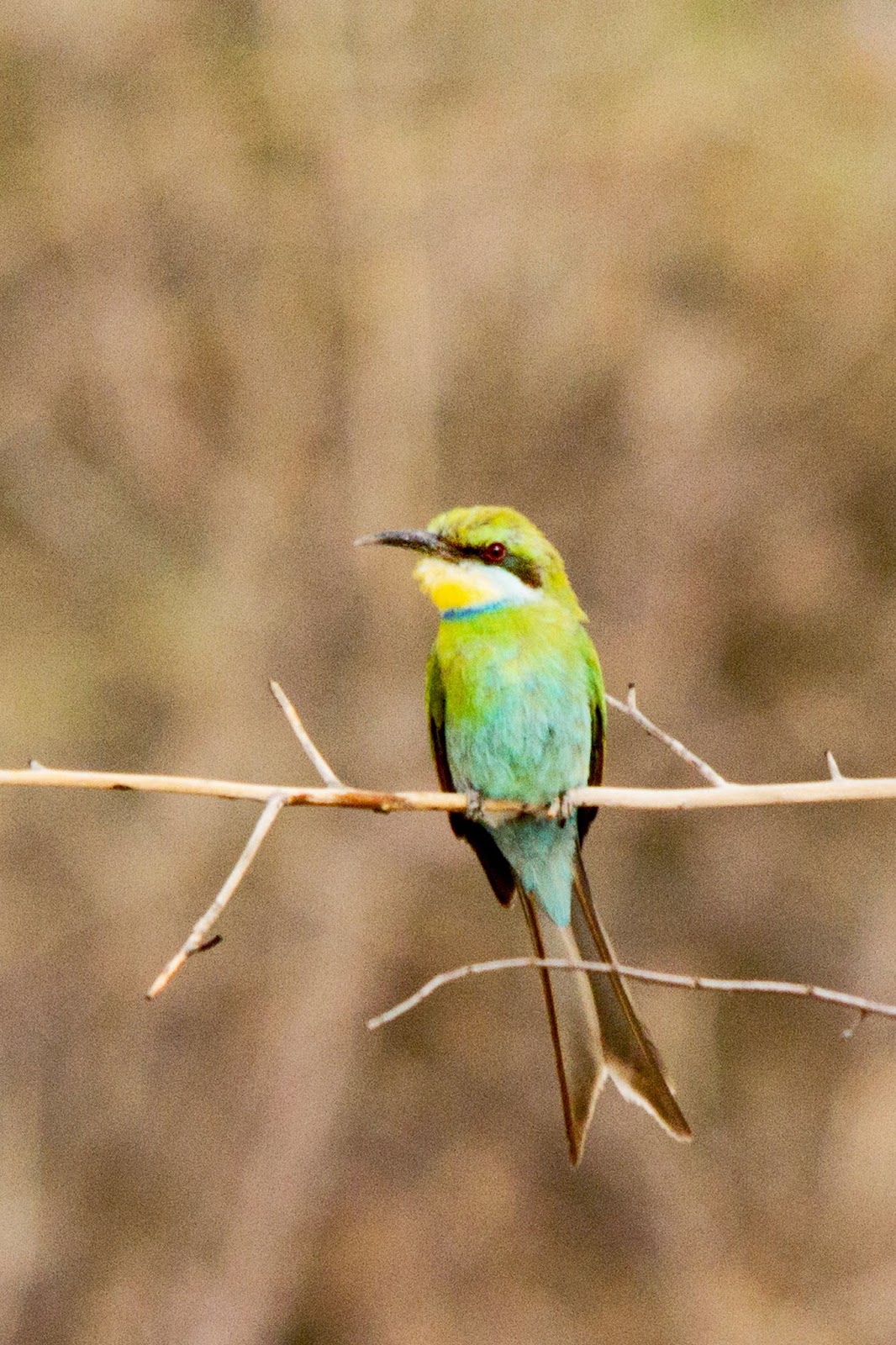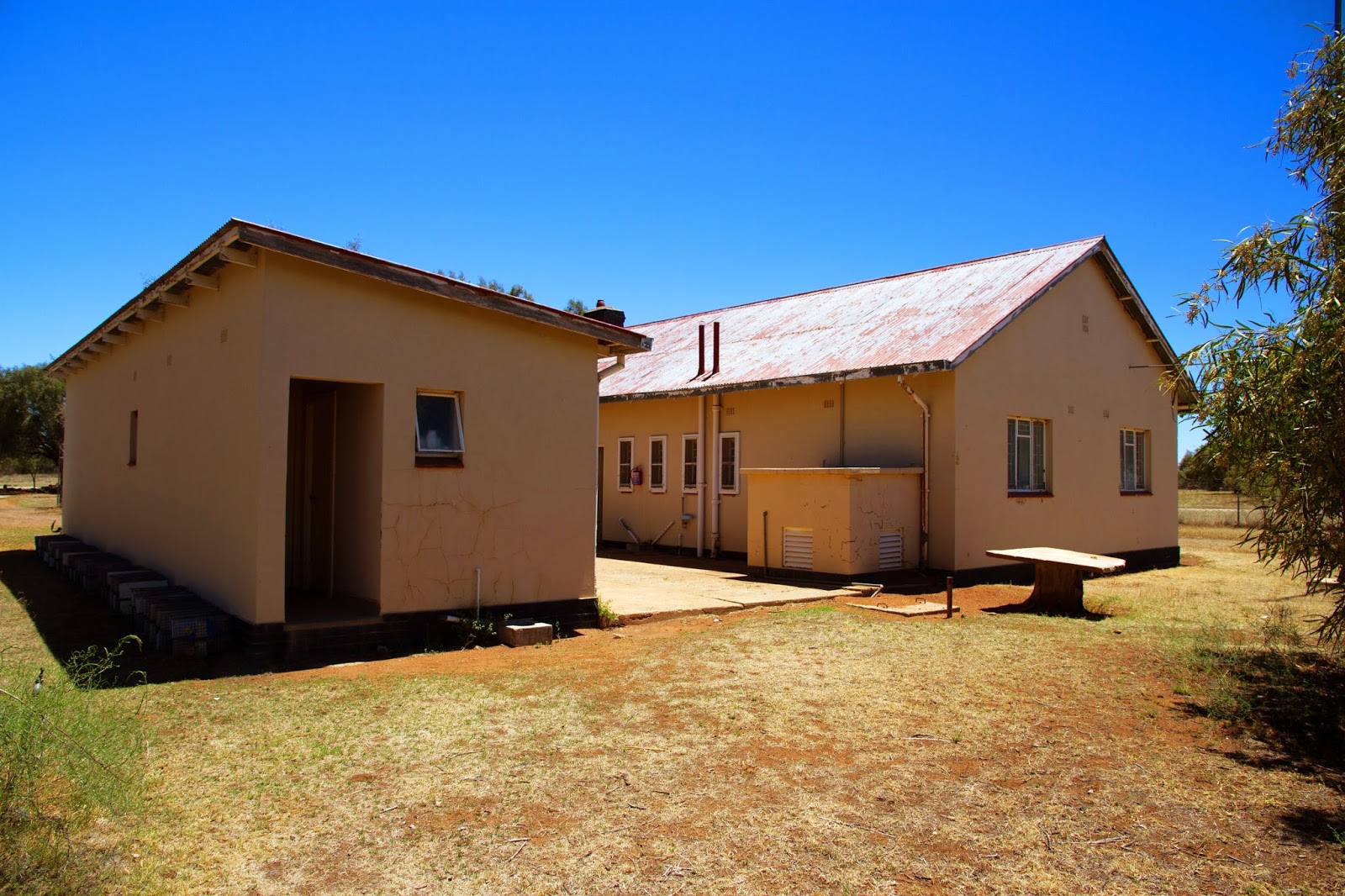 |
| Yellow billed kite flying over the Central Kalahari |
If you missed my post about part 1 of this Botswana road trip click here.
After spending the morning in the rhino sanctuary in Serowe, I hit the road again. I had about a 4.5 hour drive to a small town called Rakops, where I would stop for gas before turning west on to a small dirt track for 100km before hitting the gate for the Central Kalahari Game Reserve.
 |
| Drive from Serowe, to Rakops, and then to my campsite in the Kalahari |
According to my map, Rakops was the last place that I could fill up with fuel before heading to the game reserve, and I was spending two days there. When I got into the town, school was just getting out. I drove past an elementary school, and a bunch of the children ran after me down the road. I was glad I took this road, because I had a chance to see what a small town looked like. Many of the houses in town were made of mud/dirt walls and thatch roofs. After driving up and down the main road again, I still couldn't the gas station. I ended up asking a man for directions, who led me to a tiny building that I had passed at least four times.
Finally, I started to head west towards the game reserve. After turning on to the road, I immediately realised why you NEED a 4x4 to tour Botswana. After about 400m I was driving in about a foot and a half of loose sand. It felt like I was driving in really heavy, and slightly less slippery snow and I had to stay in second gear to avoid stalling. At this point, the wind was so strong that I couldn't see more than 20 meters on either side of the road because of the blowing sand. Even though I was already in the Kalahari desert, there were still cattle farms on either side of the road. Every once and a while I would pass a dead cow that had mummified in the sun.
 |
| Flash flood on the way into the kalahari reserve. This "river" is actually the road I drove in on |
Finally, I approached the gate of the park. I quickly signed in, payed my park fees, gulped down a can of beans and a bun (I had some very classy meals on this trip), and started heading towards my campsite. I only had about an hour and a half before sunset, so I unfortunately couldn't stop for too long on the way in.
The park was very different then what I imagined. I was expecting it to be incredibly flat and barren, with a few trees scattered here and there. Although there were plenty of areas like that, there were also huge patches of lush vegetation with lots of trees, grasses and herbaceous plants as well.
 |
| An example of a flat barren area of the Kalahari. Click to enlarge |
 |
| Just a few km away from the photo on the left, with dense thick vegetation |
I reached the first clearing to find a black backed jackal skulking around some ground squirrel burrows. You would think after spending six months observing ground squirrels I would be sick of them, but I couldn't help but stop and take a few shots of them. Besides, I didn't get that much of a chance to photograph them back on the reserve anyway.
 |
| Four young squirrels hanging out near the burrow entrance. These guys had much larger social groups than the ones we were studying in South Africa! |
 |
| Guess what the sex of this squirrel is... |
 |
| Swallow-tailed bee eater |
The next morning, I was packed up and in the truck for sunrise. I mostly booked my time in the Kalahari because I wanted to see the desert itself, but I was also hoping to see a few of the larger predators (lions, wild dogs, and hyenas are supposed to be fairly abundant in the Kalahari), and I was also hoping to get a few photos of gemsbok (pronounced hemsbok). Gemsbok have to be my favorite antelope species, so if they were all I ran into all day I would have been happy.
 |
| Black Korhaan |
The morning was actually quite slow, although I did manage to find a few species of raptors that I hadn't seen before. At one of the first pans that I drove up to, I managed to get quite close to a Black Korhaan. This is one of the most annoying bird calls of Africa, and we heard it constantly back at the reserve, but I was happy to finally get a decent photo of one.
It wasn't too long before I managed to find a few gemsbok. For whatever reason, they always decided to stand between me and the sun, so I had a heck of a time getting photos of them. The plain grey sand also made it difficult to find any contrast between the gemsbok and the background. It took me several hours to get any kind of half decent photo of one:
 |
| Gemsbok |
Overall, my first full day had been very quiet. Most of my day was
 |
| A Lion "hiding" under a tree. Why didnt I see that right away? |
On the way there, I found a fresh springbok carcass next to a water hole. I parked and faced the water hole at a good angle and waited. After waiting for a few minutes, I noticed that a pride of lions had been sitting nearby the entire time. As the night started to cool off, one of the lionesses stood up, and I almost immediately noticed several other lions and lionesses scattered under a few different trees. In the distance, a jackal was trying to sneak towards the water hole unnoticed.
 |
| Black-backed Jackal |
After watching them for quite some time, I decided I should probably find my campsite. I started the truck back up, and headed back up the road. After about 30 seconds, I was quite surprised to find myself already at the campsite. Unlike in South Africa, the campsites in Botswana have no fences whatsoever, so I was going to be spending the night about a hundred meters away from a pride of lions. I must admit that I was a little bit nervous that my dinner for the night was a steak. As I was cooking, I could hear the lions roaring in the distance. I was happy that they sounded a fair distance away, but I could still feel the bass of the roaring rumble in my chest. Fortunately, I eat my steaks quite rare so I was gorging myself as fast as I could, half out of nervousness and half out of hunger.
I noticed that an area where I had spilt some water a few minutes prior was now covered in dozens and dozens of moths. I guess if you live in a desert, you need to be able to take advantage of any water that you can find.
I crawled into my tent, feeling thankful that it was on the roof of the land cruiser. Every 10 minutes or so, I would hear some more roars coming back from the water hole. I was wondering if maybe they had already brought back a kill for the night.
The next morning I packed everything up fairly quickly, excited to see if the lions were still at the water hole. They were all still lying around, and there was no kill to be found. However, it didnt take me long to figure out what the loud roaring was about....
Apparently at least one of the lionesses was in heat, and lions are not very quiet when they mate..... After getting a few dissaproving looks from the male lion, I decided to make a final round before heading back out of the park towards Maun and the okavango delta.

Early in the morning, I managed to find a pair of bat eared foxes! This was the only pair that I managed to see during my entire trip so I was super excited. Unfortunately they were to far to get a decent photograph though. Despite being canids, these guys eat mostly insects, and use their enormous ears to locate their prey.
A little while later, I saw several Kori Bustards. This species is one of the heaviest flying birds on the planet, and can weigh up to 41 pounds. Male bustards will puff out their necks during mating displays.
 |
| Kori Bustard |
I also went back to a few of the spots where I had run into gemsbok, to try and get some nicer photos. I still had some trouble, but I managed to get a few more sightings in.
At this point it was about noon, and I had a few hours of driving to get back out of the reserve and to Maun, so I started to head back towards the entrance. On the way out, I had one of my most anticipated sightings yet. As some of you may already know, one of the animals that I wanted to see the most in Africa was the Ratel, or the Honey Badger.....
Finally, I could leave the reserve a happy man. I headed back out towards the gate, and headed North towards Maun. My next stop was the Okavanga Delta. Stay tuned to hear more about this trip!!
 |
| I cant figure out what bird this is! It looks like some kind of francolin but I cant find it in my guides. |


































